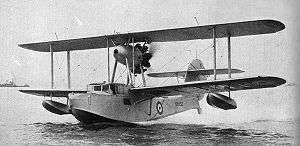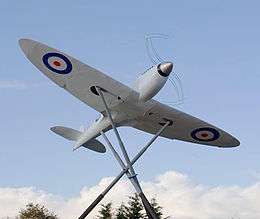R. J. Mitchell
| R.J. Mitchell | |
|---|---|
 R. J. Mitchell, aeronautical engineer | |
| Born |
20 May 1895[1] Butt Lane, Kidsgrove, Staffordshire, England |
| Died |
11 June 1937 (aged 42) Portswood, Southampton, Hampshire, England |
| Occupation | Aeronautical engineer |
| Spouse(s) |
Florence Dayson (married 1918–1937) |
| Children | Gordon Mitchell |
| Parent(s) | Herbert Mitchell[1] |
Reginald Joseph Mitchell CBE, FRAeS, (20 May 1895 – 11 June 1937) was an English aeronautical engineer, who worked for Supermarine Aviation. Between 1920 and 1936 he designed many aircraft. He is best remembered for his racing seaplanes, which culminated in the Supermarine S.6B, and an iconic Second World War fighter, the Supermarine Spitfire.
Early life
R.J. Mitchell was born at 115 Congleton Road, Butt Lane, Kidsgrove, Staffordshire, England.[2] After leaving Hanley High School, a co-educational grammar school in Stoke-on-Trent, at the age of 16, he gained an apprenticeship at Kerr Stuart & Co. of Fenton, a locomotive engineering works.[1] At the end of his apprenticeship he worked in the drawing office at Kerr Stuart and studied engineering and mathematics at night school.
Early career

In 1917 he joined the Supermarine Aviation Works at Southampton. Advancing quickly within the company, Mitchell was appointed Chief Designer in 1919.[1] He was made Chief Engineer in 1920 and Technical Director in 1927. He was so highly regarded that when Vickers took over Supermarine in 1928, one of the conditions was that Mitchell stay as a designer for the next five years.
Between 1920 and 1936, Mitchell designed 24 aircraft. As Supermarine was primarily a seaplane manufacturer, this included several flying boats such as the Supermarine Sea Eagle, the Supermarine Sea King, the Supermarine Walrus, and Supermarine Stranraer, and racing seaplanes. Mitchell also designed light aircraft, fighters, and bombers.
He was first noted in this period for his work on a series of racing seaplanes, built by Supermarine to compete in the Schneider Trophy competition. The Supermarine S.4 was entered in 1925, but crashed before the race. Two Supermarine S.5 aircraft were entered in 1927, and finished first and second. The Supermarine S.6 won in 1929. The final entry in the series, the Supermarine S.6B, marked the culmination of Mitchell's quest to "perfect the design of the racing seaplane".[3] The S.6B won the Trophy in 1931 and broke the world air speed record 17 days later.
Mitchell was awarded the CBE in 1932 for his contribution to high-speed flight.
Supermarine Spitfire fighter

If anybody ever tells you anything about an aeroplane which is so bloody complicated you can't understand it, take it from me: it's all balls.— R. J. Mitchell, advice given about his engineering staff to test pilot Jeffrey Quill during prototype trials[4]
The technical skill that Mitchell used in the design of the Spitfire was developed in the evolution of the Schneider Trophy seaplanes. The significance of the many earlier planes is often overlooked when people refer to Mitchell, as is the fact that he was very concerned about developments in Germany and feared that British defence needed to be strengthened, especially in the air.
In 1931 the Air Ministry issued specification F7/30 for a fighter aircraft to replace the Gloster Gauntlet. Mitchell's proposed design, the Type 224 was one of three designs for which the Air Ministry ordered prototypes.
The Type 224 first flew on 19 February 1934, but was eventually rejected by the RAF for unsatisfactory performance. While the 224 was being built, Mitchell was authorised by Supermarine in 1933 to proceed with a new design, the Type 300, an all-metal monoplane that would become the Supermarine Spitfire. This was originally a private venture by Supermarine, but the RAF quickly became interested and the Air Ministry financed a prototype.
Many of the technical advances in the Spitfire had been made by others: the thin elliptical wings were designed by Canadian aerodynamicist Beverley Shenstone, and shared some similarities with the Heinkel He 70 Blitz; the under-wing radiators had been designed by the RAE, while monocoque construction had been first developed in the United States. Mitchell's genius was bringing it all together with his experience of high speed flight and the Type 224.
The first prototype Spitfire, serial K5054, flew for the first time on 5 March 1936 at Eastleigh, Hampshire. In later tests, it reached 349 mph; consequently, before the prototype had completed its official trials, the RAF ordered 310 production Spitfires. Mitchell is reported to have said that "Spitfire was just the sort of bloody silly name they would choose."[5]
Later years
In August 1933, Mitchell underwent a colostomy to treat rectal cancer. Despite this, he continued to work, not only on the Spitfire, but also on a four-engined bomber, the Type 317. Unusually for an aircraft designer in those days, he took flying lessons and got his pilot's licence in July 1934.
In 1936 cancer was diagnosed again, and subsequently, in early 1937, Mitchell gave up work, although he was often seen watching the Spitfire being tested. Mitchell went to the American Foundation in Vienna for a month, but died on 11 June 1937 at age 42. His ashes were interred at South Stoneham Cemetery, Hampshire, four days later.[6][lower-alpha 1]
Legacy

Mitchell was succeeded as Chief Designer at Supermarine by Joseph Smith, who was responsible for the further development of the Spitfire. Nevertheless, Mitchell's design was so sound that the Spitfire was continually improved throughout World War II. Over 22,000 Spitfires and derivatives were built.
Mitchell's career was dramatized in the biographical film, The First of the Few (1942). He was portrayed by Leslie Howard, who also produced and directed the film, released in the United States as Spitfire (1943).
The school Mitchell attended, Hanley High School, was renamed Mitchell High School in his honour in 1989. Also, the primary school just by his birthplace (in Butt Lane, Kidsgrove, Stoke-on-Trent; built in 1909) was dedicated to him as Reginald Mitchell County Primary School.[7]
While working on the Spitfire at Woolston and Eastleigh, Mitchell lived with his wife and son in Portswood, Southampton, at a home he had built to his own design, Hazeldene, at 2 Russell Place. An English Heritage blue plaque was dedicated there on September 8, 2005, a week before the 65th anniversary of the Battle of Britain.[8] Earlier that year a blue plaque from the Newcastle Civic Society was dedicated at Mitchell's first home in Butt Lane.[9]
Gordon Mitchell told his father's story in a 1986 book,[10] revised in 1997 and updated in 2002[11] as R. J. Mitchell: Schooldays to Spitfire.[12]
On March 5, 2004, Mitchell unveiled a 3/4-scale representation of the prototype Spitfire K5054 at the entrance to Southampton Airport (formerly known as Eastleigh Aerodrome), Southampton, on the 68th anniversary of its first flight. The sculpture was created by Alan Manning.[13]
American philanthropist Sidney Frank unveiled a statue of R. J. Mitchell at London's Science Museum on September 15, 2005. Made from hundreds of small pieces of Welsh slate, the statue shows Mitchell standing at his drawing board.[14] The slate drawing board's surface is incised with the image of the June 1936 drawing of the prototype Spitfire K5054.[15] The stone sculpture was created by Stephen Kettle and given to the museum by the Sidney E. Frank Foundation.[16] Frank also commissioned a web site commemorating Mitchell's life and achievements.[17]
In 2006 Gordon Mitchell received a letter from Prince Philip, Duke of Edinburgh, supporting his efforts to rename Southampton Airport in honor of his father.[18] A tireless proponent of his father's legacy, Mitchell died in 2009, aged 88.[19]
In 2012, a road at the Advanced Manufacturing Park in Rotherham, England, was named Mitchell Way in honour of the Spitfire designer. All roads at the AMP are named after famous engineers and designers.
Notes
- ↑ South Stoneham cemetery is not located at either South Stoneham Church or North Stoneham Church. The cemetery where Mitchell is buried is located approximately 1km between both churches.
References
- 1 2 3 4 Price 1982, p. 11.
- ↑ Ritchie, Sebastian. "Mitchell, Reginald Joseph (1895–1937)." Oxford Dictionary of National Biography, Oxford University Press, September 2004. Retrieved: 21 August 2010.
- ↑ Price 1977, p. 11.
- ↑ Quill (1983), p. 102.
- ↑ Deighton 1977, p. 99.
- ↑ Mitchell, Gordon (2009). "A biography of R.J. Mitchell". RJ Mitchell. A life in aviation. Retrieved 2015-12-16.
- ↑ Jamieson, Alastair (27 February 2011). "Family of Spitfire designer angry over renamed school". The Daily Telegraph. Retrieved 25 July 2015.
- ↑ "Plaque for Spitfire man's city home". This is Hampshire (UK Newsquest Regional Press). September 8, 2005.
- ↑ Naylor, L. Aura (September 8, 2005). "Plaque honour for spitfire designer". The Sentinel (Stoke).
- ↑ Mitchell, Gordon (1986). R.J. Mitchell: World Famous Aircraft Designer: Schooldays to Spitfire. Olney: Nelson & Saunders Publishers. ISBN 9780947750053.
- ↑ Price, Brian (April 11, 2002). "Spitfire hero's secret cancer battle". Western Daily Press.
- ↑ Mitchell, Gordon (2006). R. J. Mitchell: Schooldays to Spitfire. Stroud: Tempus Publishing. ISBN 9780752437279.
- ↑ "It's so plane to see German link to Spitfire tribute". This Is Hampshire (UK Newsquest Regional Press). March 4, 2004.
- ↑ "Fitting tribute to the man who created the Spitfire". Birmingham Post. September 16, 2005. Retrieved 2015-12-16.
- ↑ Mitchell, Gordon (2009). "RJ Mitchell Statue at the Science Museum". RJ Mitchell. A life in aviation. Retrieved 2015-12-17.
- ↑ "Stone sculpture of R. J. Mitchell". Science Museum. Retrieved 2015-12-17.
- ↑ "About Sidney Frank". RJ Mitchell. A life in aviation. Retrieved 2015-12-17.
- ↑ "Duke backs airport name". Gloucester Echo. August 28, 2006.
- ↑ "Son of Spitfire designer dies". Gloucester Citizen. July 27, 2009. Retrieved 2015-12-15.
Bibliography
- Deighton, Len. Fighter: The True Story of the Battle of Britain. London: Grafton, 1977. ISBN 0-7858-1208-3.
- Dibbs, John and Tony Holmes. Spitfire: Flying Legend. Southampton, UK: Osprey Publishing, 1997. ISBN 1-84176-005-6.
- Eforgan, Estel. Leslie Howard: The Lost Actor. London: Vallentine Mitchell, 2010. ISBN 978-0-85303-941-9.
- McKinstry, Leo. Spitfire: Portrait of a Legend. London: John Murray, 2007. ISBN 978-0-7195-6874-9.
- Mitchell, Gordon. R.J. Mitchell: Schooldays to Spitfire. London: Tempus Publishing, 2006. ISBN 0-7524-3727-5.
- Palfrey, Brett R. and Christopher Whitehead. "Supermarine Spitfire: History of a Legend." Royal Air Force (RAF). Retrieved: 27 December 2006.
- Price, Alfred. The Spitfire Story. London: Silverdale Books, 1995. ISBN 1-85605-702-X.
- Price, Alfred. Spitfire: A Documentary History. New York: Charles Scribner's Sons, 1997. ISBN 0-684-16060-9.
- Quill, Jeffrey. Spitfire: A Test Pilot’s Story. London: Crécy Publishing, 1998; Air Data, 1996; John Murray, 1983 (first edition). ISBN 9-780947-554729.
- Shelton, John (2008). Schneider Trophy to Spitfire - The Design Career of R.J. Mitchell (Hardback). Sparkford: Hayes Publishing. ISBN 978-1-84425-530-6.
External links
| Wikimedia Commons has media related to R J Mitchell. |
- Awareness campaign for RJ Mitchell
- BBC Local Heroes
- Spitfire Display at The Potteries Museum & Art Gallery, Stoke-on-Trent
- R J Mitchell Primary School Facebook Page
- Supermarine Spitfire prototype
- Spitfires and Spitfire pilots
- Dr. Gordon Mitchell
| ||||||||||||||||||||||||||||||||||||
|